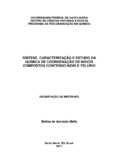| dc.creator | Mello, Melina de Azevedo | |
| dc.date.accessioned | 2012-03-06 | |
| dc.date.available | 2012-03-06 | |
| dc.date.issued | 2011-07-29 | |
| dc.identifier.citation | MELLO, Melina de Azevedo. Synthesis, characterization and study of the coordination chemistry of new compounds containing Indium and Tellurium. 2011. 75 f. Dissertação (Mestrado em Química) - Universidade Federal de Santa Maria, Santa Maria, 2011. | por |
| dc.identifier.uri | http://repositorio.ufsm.br/handle/1/10491 | |
| dc.description.abstract | In this work we describe the synthesis and characterization of the first indium
and tellurium compounds in which tellurium shows metallic behavior towards indium.
We have studied the coordination chemistry of indium and tellurium, in different
oxidation states and in the presence of different ligands, in order to understand the
interactions that occur between these species.
Indium(III) halides - InX3 (X = Cl, Br) react with phenyltellurium(IV) trihalides -
PhTeX3 (X = Cl, Br) and hard ligands such as OPPh3, 1,10-phenantroline and DMSO,
to yield [InX2(OPPh3)4]+[PhTeX4]- (X = Br, 1; X = Cl, 2), [InBr2(1,10-phen)2]+[PhTeBr4]-
(3) and [InBr2(DMSO)4]+[PhTeBr4]- (4). Differently, with soft ligands such as thioureas,
the reduction reaction of Te(IV) to Te(II) is favored. When PhTeX3 is substituted by
TeCl4 the Lewis acid character of In(III) prevails over the hard/soft relation between In
and Te. This leads to the formation of a compound containing only In,
[InCl2(OPPh3)4]+[InCl4]- (5). No reaction is observed between InX3 and Te(II) species
with hard or soft ligands. The compound [InI2(DPPMO2)2]+[InI4]- (6) (DPPMO2 =
bis(diphenylphosphine)methane dioxide), obtained from the reaction between InI3
and PhTeI phenyltellurium(II) iodide indicates that reaction between In(III) and
Te(II) does not occur due to once more prevails the Lewis acid character of In(III)
over the hard/soft relation between In and Te. | eng |
| dc.description.sponsorship | Conselho Nacional de Desenvolvimento Científico e Tecnológico | |
| dc.format | application/pdf | por |
| dc.language | por | por |
| dc.publisher | Universidade Federal de Santa Maria | por |
| dc.rights | Acesso Aberto | por |
| dc.subject | Haletos de índio(III) | por |
| dc.subject | Espécies de telúrio | por |
| dc.subject | Química de coordenação | por |
| dc.subject | Indium(III) halides | eng |
| dc.subject | Tellurium species | eng |
| dc.subject | Coordination chemistry | eng |
| dc.title | Síntese, caracterização e estudo da química de coordenação de novos compostos contendo Índio e Telúrio | por |
| dc.title.alternative | Synthesis, characterization and study of the coordination chemistry of new compounds containing Indium and Tellurium | eng |
| dc.type | Dissertação | por |
| dc.description.resumo | Neste trabalho estão descritas a síntese e a caracterização dos primeiros
compostos envolvendo índio e telúrio nos quais o telúrio apresenta comportamento
metálico frente ao índio. Foi desenvolvido um estudo da química de coordenação
entre os elementos índio e telúrio em diferentes estados de oxidação, na presença
de diferentes ligantes, com o intuito de compreender as interações que ocorrem
entre esses elementos.
Haletos de índio(III) InX3 (X = Cl, Br) reagem com haletos de
feniltelúrio(IV) PhTeX3 (X = Cl, Br) na presença de ligantes duros como OPPh3,
1,10-fenantrolina e DMSO para gerar os compostos [InX2(OPPh3)4]+[PhTeX4]- (X =
Br, 1; Cl, 2), [InBr2(1,10-phen)2]+[PhTeBr4]- (3) e [InBr2(DMSO)4]+[PhTeBr4]- (4).
Porém, com ligantes macios como tiouréias, a reação de redução do Te(IV) para
Te(II) é preferencial. Quando se substitui o PhTeX3 por TeCl4, prevalece o caráter
ácido de Lewis do In(III) sobre a relação duro/macio entre In e Te, levando a
formação do composto contendo apenas In, [InCl2(OPPh3)4]+[InCl4]- (5). Não é
observada reação entre InX3 e espécies de Te(II) com ligantes duros ou macios. O
composto [InI2(DPPMO2)2]+[InI4]- (6) (DPPMO2 = Bis(difenilfosfina)metanodióxido),
obtido da reação entre InI3 e PhTeI iodeto de feniltelúrio(II) leva a crer que In(III)
e Te(II) não reagem entre si pois novamente prevalece o caráter ácido de Lewis do
In(III) sobre a relação duro/macio entre In e Te. | por |
| dc.contributor.advisor1 | Lang, Ernesto Schulz | |
| dc.contributor.advisor1Lattes | http://lattes.cnpq.br/4481982189769819 | por |
| dc.contributor.referee1 | Santos, Marcos Jose Leite | |
| dc.contributor.referee1Lattes | http://lattes.cnpq.br/2262136591316649 | por |
| dc.contributor.referee2 | Giacomelli, Cristiano | |
| dc.contributor.referee2Lattes | http://lattes.cnpq.br/1429116139250396 | por |
| dc.creator.Lattes | http://lattes.cnpq.br/1103076853141835 | por |
| dc.publisher.country | BR | por |
| dc.publisher.department | Química | por |
| dc.publisher.initials | UFSM | por |
| dc.publisher.program | Programa de Pós-Graduação em Química | por |
| dc.subject.cnpq | CNPQ::CIENCIAS EXATAS E DA TERRA::QUIMICA | por |


